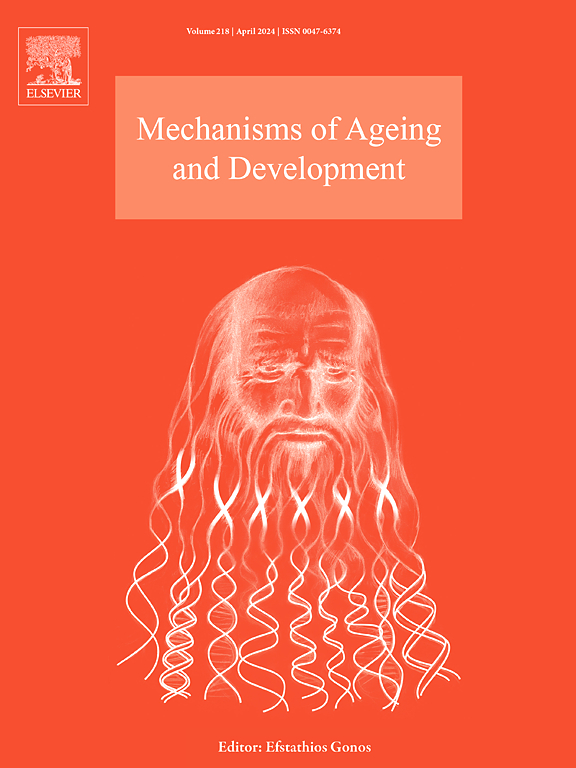衰老肺泡上皮细胞中的IRF1-RIG-I信号缺陷可能导致肺部抗病毒免疫反应下降。
IF 5.1
3区 医学
Q2 CELL BIOLOGY
引用次数: 0
摘要
背景:肺泡上皮细胞(AECs)是许多病原体的主要靶点,在病毒感知和免疫调节中起着重要作用。然而,对老年aec的抗病毒反应知之甚少。方法:采用流式细胞术、实时荧光定量PCR、Western blot检测、transwell趋化试验等方法分析年轻、老年AECs感染病毒后的反应。采用深度测序和KEGG分析确定与老年AECs相关的关键通路和基因,然后进行功能分析。结果:甲型流感病毒(IAV)感染老年aec后,视黄酸诱导基因I (RIG-I)信号通路存在缺陷。干扰素调节因子1 (IRF1)结合RIG-I基因Ddx58的启动子激活其表达。IRF1的调控在老年小鼠aec中也存在缺陷。pr8感染的老年aec细胞上清中募集的NK细胞、单核细胞和T细胞较少。重要的是,IRF1-RIG-I信号在IAV感染后的老年人aec中也受到损害。结论:衰老损害了AECs中irf1 - rig - 1信号通路,AECs应答缺陷可能导致肺部病毒感染后老年人免疫细胞募集和激活减少。本文章由计算机程序翻译,如有差异,请以英文原文为准。
IRF1-RIG-I signaling defects in the aged alveolar epithelial cells may contribute to decreased pulmonary antiviral immune responses
Background
Alveolar epithelial cells (AECs) are the primary targets of many pathogens and play an important role in sensing viruses and regulating immunity. Yet, little is known about the antiviral responses in the aged AECs.
Methods
The responses of young or aged AECs after viral infection were analyzed using methods such as flow cytometry, quantitative real-time PCR, Western blot detection, and transwell chemotaxis assay. Deep sequencing and KEGG analysis were used to identify key pathways and genes associated with aged AECs, followed by functional analysis.
Results
The retinoic acid-inducible gene I (RIG-I) signaling is defective in aged AECs after influenza A virus (IAV) infection. The interferon regulatory factor 1 (IRF1) binds the promoter of RIG-I gene Ddx58 to activate its expression. The regulation of IRF1 is also defective in AECs from aged mice. Fewer NK cells, monocytes, and T cells are recruited by the cell supernatant from PR8-infected aged AECs. Importantly, IRF1-RIG-I signaling is also impaired in the AECs of elderly people after IAV infection.
Conclusion
Ageing impairs IRF1-RIG-I signaling in AECs, and the defective responses in AECs may contribute to reduced immune cell recruitment and activation in aged individuals after pulmonary viral infection.
求助全文
通过发布文献求助,成功后即可免费获取论文全文。
去求助
来源期刊
CiteScore
11.10
自引率
1.90%
发文量
79
审稿时长
32 days
期刊介绍:
Mechanisms of Ageing and Development is a multidisciplinary journal aimed at revealing the molecular, biochemical and biological mechanisms that underlie the processes of aging and development in various species as well as of age-associated diseases. Emphasis is placed on investigations that delineate the contribution of macromolecular damage and cytotoxicity, genetic programs, epigenetics and genetic instability, mitochondrial function, alterations of metabolism and innovative anti-aging approaches. For all of the mentioned studies it is necessary to address the underlying mechanisms.
Mechanisms of Ageing and Development publishes original research, review and mini-review articles. The journal also publishes Special Issues that focus on emerging research areas. Special issues may include all types of articles following peered review. Proposals should be sent directly to the Editor-in-Chief.

 求助内容:
求助内容: 应助结果提醒方式:
应助结果提醒方式:


